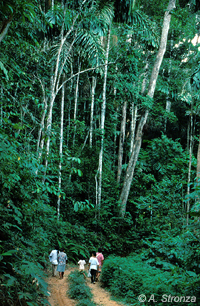
The Western Amazon basin is one of the most biologically diverse regions on earth (Foster et al. 1994; Terborgh et al. 1990) and is marked by great human diversity, including uncontacted indigenous peoples, legally-titled indigenous communities, second-generation colonists and mestizos, Aymara and Quechua-speaking colonists from the highlands, and international ecotourists (Chicchon 2001). It is one of the most pristine regions in the Americas, largely due to lack of transportation and access. There are over five million hectares of government protected areas, a size greater than the total land area of Costa Rica (INRENA 2005). This includes the Bahuaja-Sonene National Park and Manu National Park in southeastern Peru. However, threats from logging, gold mining, over-harvesting of game, fish and forest products, expansion of ranching, coca cultivation, and wildlife trafficking are continually increasing (Alvarez and Naughton-Treves 2003).
People are also being impacted. Indigenous and long-established communities face challenges of new settlers claiming their territories. There is little support from regional and national governments, poor access to credit and extension services, low prices and unstable markets for produce, poor infrastructures for education, health and transportation, and loss of cultural identity in the rapidly modernizing area (Coomes and Barham 1997). Recent plans for the Trans-Oceanic Highway connecting the heart of the Peruvian Amazon to markets in Lima and Brazil threaten to end the isolation that has protected this area (Naughton-Treves 2004). Similar plans exist to connect cities to the western Amazon in Bolivia, a change that will have significant ecological and social ramifications in the coming decades. In some areas this process is just beginning, and there is still time to mitigate some of the effects of road building.
View Western Amazon Photo Album
Literature Cited:
Alvarez, N.L, L. Naughton-Treves 2003 Linking National Agrarian Policy to Deforestation in the Peruvian Amazon: A Case Study of Tambopata Ambio 32(4)269-274.
Chicchon, Avecita 2001. Conservation Theory Meets Practice. Conservation Biology 14 (5), 1368-1369.
Coomes, O.T, and Barham, B. 1997 Rainforest extraction and conservation in Amazonia. The Geographical Journal 163(2): 180-188.
Foster R. B., T. A. Parker, A. H. Gentry, L. H. Emmons, A. Chicchón, T. Schulenberg, L. Rodríguez, et al. 1994. The Tambopata-Candamo Reserved Zone of southeastern Peru: a biological assessment. RAP Bulletin, no. 6. Conservation International, Washington, D.C.
INRENA. 2005. Sistema Nacional de Areas Naturales Protegidas por el Estado – SINAP. Indendencia de Areas Naturales Protegidas, Instituto Nacional de Recursos Naturales. Electronic Resource http://www.inrena.gob.pe/ianp/ianp_sinanpe_pagweb.htm, last accessed Aug 2006.
Naughton-Treves, L. 2004. Deforestation and carbon emissions at tropical frontiers: a case study from the Peruvian Amazon. World Development 32:173-190.
Terborgh, J., S. K. Robinson, T. A. P. III, C. A. Munn, and N. Pierpont. 1990. Structure and organization of an Amazonian forest bird community. Ecological Monographs 60:213-238.

